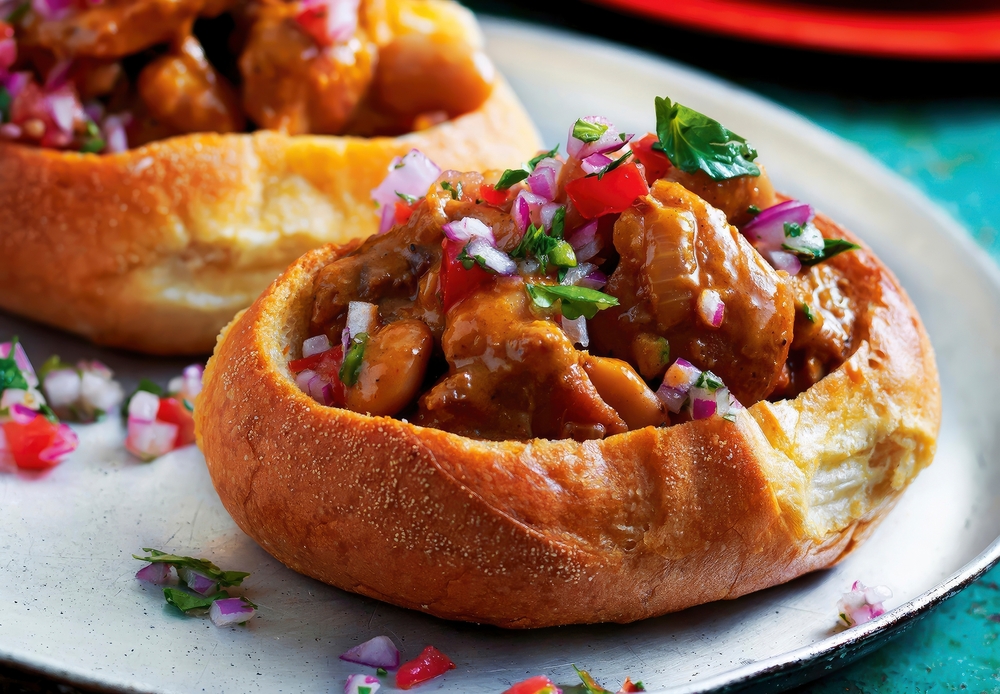Bunny Chow: A Mouthful of South African History and Flavor
Amidst the diverse culinary landscape of South Africa, one dish has captivated hearts and appetites alike – the Bunny Chow. A hollowed-out loaf of bread generously filled with spicy curry, Bunny Chow offers a hearty meal and a bite into the rich tapestry of South African cultural influences.
Bunny Chow’s Tale: From Durban to the World
Born in the vibrant Indian community of Durban, Bunny Chow has its roots in the necessity and ingenuity of Indian laborers who needed a portable meal. This dish not only reflects South Africa’s multicultural essence but also stands as a testament to the adaptability and creativity of its people.
Constructing a Bunny Chow: Ingredients & Quantities
- For the curry filling:
- 500g chicken or beef, diced
- 2 large onions, finely chopped
- 3 cloves garlic, minced
- 1 tbsp ginger, grated
- 2 tbsp curry powder (adjust to preference)
- 1 tsp turmeric powder
- 2 tomatoes, pureed
- 2 potatoes, diced
- 1 bay leaf
- Salt to taste
- Oil for cooking
- 1 medium-sized loaf of white bread
Step-by-Step: Crafting the Perfect Bunny Chow
- Preparing the Curry: In a large pot, heat oil over medium heat. Sauté onions until translucent. Add garlic and ginger, cooking for another 2 minutes.
- Stir in the curry powder, turmeric, and bay leaf. Fry the spices briefly until aromatic. Add the diced meat, ensuring it is well-coated with the spices. Brown the meat on all sides.
- Add the pureed tomatoes to the pot, followed by the diced potatoes. Add salt and enough water to cover the ingredients. Bring to a boil, then reduce heat and simmer until the meat is tender and the curry is thickened.
- Assembling the Bunny Chow: Cut the bread loaf into quarters. Hollow out the center of each quarter, leaving a thick bread wall. Fill the hollowed bread generously with the prepared curry. Optionally, use the scooped-out bread as a ‘lid’ or simply as an accompaniment to soak up the curry.
- Best served hot. Dive in using your fingers for the authentic Bunny Chow experience!
Tip: While chicken and beef are popular choices, Bunny Chow can also be made with lamb, pork, or even vegetarian fillings.

Beyond Food: Bunny Chow as a Cultural Icon
In the heart of South African street food culture, Bunny Chow stands not just as a dish, but as a symbol of unity, collaboration, and shared history. Its story of origin and evolution mirrors the nation’s journey through challenges and triumphs.
Diving Deeper: Bunny Chow FAQs
1. Why is it called “Bunny” Chow?
The term “bunny” is derived from the word “bania”, referring to the Indian merchant class who are believed to have created this dish.
2. Is Bunny Chow found outside South Africa?
While quintessentially South African, Bunny Chow’s fame has spread globally, with variations being offered in restaurants worldwide. However, for the authentic taste, Durban remains the place to be.
3. How do I eat Bunny Chow?
The traditional way is to dive in with your fingers, using the bread to scoop up the curry. It’s a deliciously messy affair that’s part of the Bunny Chow charm.
4. Are there variations to the classic Bunny Chow?
Absolutely! From the choice of meat to vegetarian options with beans or lentils, the possibilities are as diverse as South Africa itself.
5. How did a dish of Indian origins become a South African staple?
The blending of Indian flavors with South African ingredients and sensibilities led to the birth of Bunny Chow. Over time, its taste and the story resonated with diverse communities, making it a beloved national dish.
Bunny Chow is a standout in the diverse realm of African street eats. Learn more about it!
